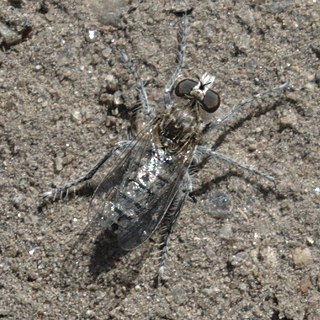
Biological databases are libraries of biological sciences, collected from scientific experiments, published literature, high-throughput experiment technology, and computational analysis. They contain information from research areas including genomics, proteomics, metabolomics, microarray gene expression, and phylogenetics. Information contained in biological databases includes gene function, structure, localization, clinical effects of mutations as well as similarities of biological sequences and structures.

Sphaerites is a genus of beetles, the only genus in the family Sphaeritidae, sometimes called the false clown beetles. There are five known species, which are widespread in temperate areas of the Northern Hemisphere, found in forested or upland areas.
Tauchira is a genus of grasshoppers (Acrididae) in the subfamily Catantopinae and tribe Tauchirini. Species can be found in South-East Asia.
The Catalogue of Life is an online database that provides an index of known species of animals, plants, fungi, and microorganisms. It was created in 2001 as a partnership between the global Species 2000 and the American Integrated Taxonomic Information System. The Catalogue is used by research scientists, citizen scientists, educators, and policy makers. The Catalogue is also used by the Biodiversity Heritage Library, the Barcode of Life Data System, Encyclopedia of Life, and the Global Biodiversity Information Facility. The Catalogue currently compiles data from 165 peer-reviewed taxonomic databases that are maintained by specialist institutions around the world. As of September 2022, the COL Checklist lists 2,067,951 of the world's 2.2m extant species known to taxonomists on the planet at present time.

The Encyclopedia of Life (EOL) is a free, online encyclopedia intended to document all of the 1.9 million living species known to science. It aggregates content to form "pages" for every known species. Content is compiled from existing trusted databases which are curated by experts and it calls on the assistance of non-experts throughout the world. It includes video, sound, images, graphics, information on characteristics, as well as text. In addition, the Encyclopedia incorporates species-related content from the Biodiversity Heritage Library, which digitizes millions of pages of printed literature from the world's major natural history libraries. The BHL digital content is indexed with the names of organisms using taxonomic indexing software developed by the Global Names project. The EOL project was initially backed by a US$50 million funding commitment, led by the MacArthur Foundation and the Sloan Foundation, who provided US$20 million and US$5 million, respectively. The additional US$25 million came from five cornerstone institutions—the Field Museum, Harvard University, the Marine Biological Laboratory, the Missouri Botanical Garden, and the Smithsonian Institution. The project was initially led by Jim Edwards and the development team by David Patterson. Today, participating institutions and individual donors continue to support EOL through financial contributions.

Elaphropus is a genus of ground beetles in the family Carabidae. There are at least 370 described species in Elaphropus.
Tomopterus is a genus of beetles in the family Cerambycidae, containing the following species:

iNaturalist is an American 501(c)(3) nonprofit social network of naturalists, citizen scientists, and biologists built on the concept of mapping and sharing observations of biodiversity across the globe. iNaturalist may be accessed via its website or from its mobile applications. iNaturalist includes an automated species identification tool, and users further assist each other in identifying organisms from photographs and even sound recordings. As of 9 July 2024, iNaturalist users had contributed approximately 197,660,888 observations of plants, animals, fungi, and other organisms worldwide, and 290,007 users were active in the previous 30 days.
Jordanoleiopus rufotibialis is a species of beetle in the family Cerambycidae. It was described by Breuning in 1977.
Dolichoderus rufotibialis is a species of ant in the genus Dolichoderus. Described by John S. Clark in 1930, the species is endemic to Australia.
Lasiocercis rufotibialis is a species of beetle in the family Cerambycidae. It was described by Stephan von Breuning in 1957.
Ganoblemmus is a genus of crickets in the tribe Gryllini; species are recorded from Africa.
Phytoecia algerica is a species of beetle in the family Cerambycidae. It was described by Desbrochers in 1870. It is known from Morocco, Algeria, and Spain. It feeds on Artemisia arborescens.
Mimolagrida rufa is a species of beetle in the family Cerambycidae. It was described by Stephan von Breuning in 1947. It is known from Madagascar.

Lordotus is a genus of bee flies. There are at least 30 described species in Lordotus.

Lymeon is a genus of ichneumon wasps in the family Ichneumonidae. There are at least 80 described species in Lymeon.

Ablautus is a genus of robber flies in the family Asilidae.
Ablautus schlingeri, the oso flaco robber fly, is a species of robber flies in the family Asilidae.
Ablautus vanduzeei is a species of robber flies in the family Asilidae.








